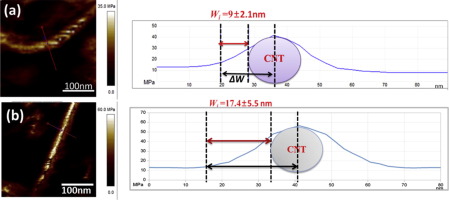当前位置:
X-MOL 学术
›
Eur. Polym. J.
›
论文详情
Our official English website, www.x-mol.net, welcomes your feedback! (Note: you will need to create a separate account there.)
A Quantitative Approach to Study the Interface of Carbon Nanotubes/Elastomer nanocomposites
European Polymer Journal ( IF 6 ) Pub Date : 2018-05-01 , DOI: 10.1016/j.eurpolymj.2018.03.007 Nanying Ning , Tong Mi , Guangyu Chu , Li-Qun Zhang , Li Liu , Ming Tian , Hai-Tao Yu , Yong-Lai Lu
European Polymer Journal ( IF 6 ) Pub Date : 2018-05-01 , DOI: 10.1016/j.eurpolymj.2018.03.007 Nanying Ning , Tong Mi , Guangyu Chu , Li-Qun Zhang , Li Liu , Ming Tian , Hai-Tao Yu , Yong-Lai Lu

|
Abstract The interface between nanofillers and elastomers is one of the most important factors to determine the performance of elastomer nanocomposites. In this study, for the first time, we developed a method to quantitatively characterize the interfacial layer thickness of carbon nanotubes (CNTs)/Natural rubber (NR) composites by using peak force quantitative nanomechanical mapping (PF-QNM) technique of atomic force microscopy (AFM). We obtained the modulus and adhesion distribution of the composites, and selected those CNTs close to the sample surface, where the CNTs show lower adhesion for the accurate characterization of the interfacial thickness. Then, we characterized the thickness of interfacial layer according to the gradient change in Young’s modulus. The results show that the average interfacial thickness of CNTs/NR composites is about 9 nm, similar with that in carbon black (CB)/elastomer composite (10 nm) reported in previous study, indicating the good interfacial interaction between CNTs and NR matrix. The average interfacial thickness of the modified CNTs/NR composites is about 17.4 nm, indicating the stronger interfacial interaction. The “Payne effect” and mechanical properties of these nanocomposites were also examined, and the results were consistent well with the AFM PF-QNM results. This study provides a new method to quantitative characterize the interface between filler and elastomer matrix at nanoscale resolution.
中文翻译:

研究碳纳米管/弹性体纳米复合材料界面的定量方法
摘要 纳米填料与弹性体之间的界面是决定弹性体纳米复合材料性能的最重要因素之一。在这项研究中,我们首次开发了一种方法,通过使用原子力显微镜的峰值力定量纳米力学映射 (PF-QNM) 技术定量表征碳纳米管 (CNTs)/天然橡胶 (NR) 复合材料的界面层厚度(原子力显微镜)。我们获得了复合材料的模量和粘附力分布,并选择了靠近样品表面的那些碳纳米管,其中碳纳米管显示出较低的粘附力以准确表征界面厚度。然后,我们根据杨氏模量的梯度变化表征界面层的厚度。结果表明,CNTs/NR 复合材料的平均界面厚度约为 9 nm,与之前研究中报道的炭黑(CB)/弹性体复合材料(10 nm)的界面厚度相似,表明 CNTs 与 NR 基体之间具有良好的界面相互作用。改性CNTs/NR复合材料的平均界面厚度约为17.4 nm,表明界面相互作用更强。还检查了这些纳米复合材料的“佩恩效应”和机械性能,结果与 AFM PF-QNM 结果一致。这项研究提供了一种以纳米级分辨率定量表征填料和弹性体基体之间界面的新方法。改性CNTs/NR复合材料的平均界面厚度约为17.4 nm,表明界面相互作用更强。还检查了这些纳米复合材料的“佩恩效应”和机械性能,结果与 AFM PF-QNM 结果一致。这项研究提供了一种以纳米级分辨率定量表征填料和弹性体基体之间界面的新方法。改性CNTs/NR复合材料的平均界面厚度约为17.4 nm,表明界面相互作用更强。还检查了这些纳米复合材料的“佩恩效应”和机械性能,结果与 AFM PF-QNM 结果一致。这项研究提供了一种以纳米级分辨率定量表征填料和弹性体基体之间界面的新方法。
更新日期:2018-05-01
中文翻译:

研究碳纳米管/弹性体纳米复合材料界面的定量方法
摘要 纳米填料与弹性体之间的界面是决定弹性体纳米复合材料性能的最重要因素之一。在这项研究中,我们首次开发了一种方法,通过使用原子力显微镜的峰值力定量纳米力学映射 (PF-QNM) 技术定量表征碳纳米管 (CNTs)/天然橡胶 (NR) 复合材料的界面层厚度(原子力显微镜)。我们获得了复合材料的模量和粘附力分布,并选择了靠近样品表面的那些碳纳米管,其中碳纳米管显示出较低的粘附力以准确表征界面厚度。然后,我们根据杨氏模量的梯度变化表征界面层的厚度。结果表明,CNTs/NR 复合材料的平均界面厚度约为 9 nm,与之前研究中报道的炭黑(CB)/弹性体复合材料(10 nm)的界面厚度相似,表明 CNTs 与 NR 基体之间具有良好的界面相互作用。改性CNTs/NR复合材料的平均界面厚度约为17.4 nm,表明界面相互作用更强。还检查了这些纳米复合材料的“佩恩效应”和机械性能,结果与 AFM PF-QNM 结果一致。这项研究提供了一种以纳米级分辨率定量表征填料和弹性体基体之间界面的新方法。改性CNTs/NR复合材料的平均界面厚度约为17.4 nm,表明界面相互作用更强。还检查了这些纳米复合材料的“佩恩效应”和机械性能,结果与 AFM PF-QNM 结果一致。这项研究提供了一种以纳米级分辨率定量表征填料和弹性体基体之间界面的新方法。改性CNTs/NR复合材料的平均界面厚度约为17.4 nm,表明界面相互作用更强。还检查了这些纳米复合材料的“佩恩效应”和机械性能,结果与 AFM PF-QNM 结果一致。这项研究提供了一种以纳米级分辨率定量表征填料和弹性体基体之间界面的新方法。



























 京公网安备 11010802027423号
京公网安备 11010802027423号